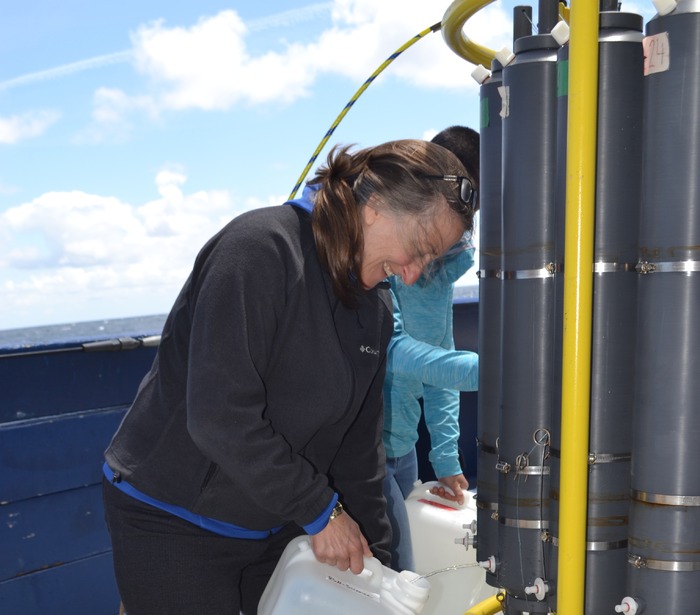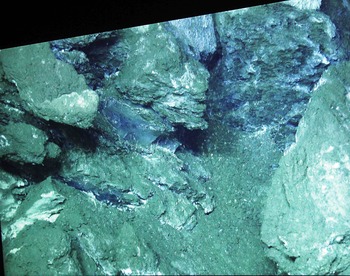It is clear, the Cabled Array, like raising children, takes a village and is a labor of love for the many "villagers" on this expedition.
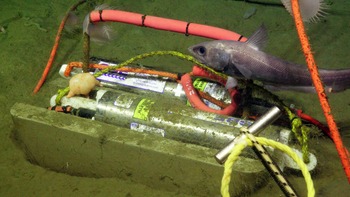
A rattail fish (Grenadier) investigates two pressure sensors at 9500 ft water depth at the sedimented Slope Base site. The one in the background has been equilibrating since 2017 on the seafloor. Venus fly-trap like anenomies have colonized the cables that allow data to flow to shore in real-time, and a feeding sea star is on the dusty, 2014 sensor. Credit: UW/NSF-OOI/WHOI, V18.
June 28, 2018: Success is Sweet
I slid into bed at 2 am and cat napped until 5:30 am when the alarm on my phone went off. Just like home, I hit the snooze for 4 minutes longer. At home, I often hit snooze 3 or 4 times, but on the R/V Roger Revelle I can't hit the snooze again. There is simply too much cool science to learn, film to watch, and a morning shift of 5:45 - 8 am in Jason's control van beckoning.
Today is a much anticipated day for the two scientists, Yann Marcon and Ulli Spiesecke, from Bremen, Germany. They will deploy, the first of its kind, cabled MARUM multibeam sonar (M3) which records 360 degrees to be able to create 3D images and a second cabled smaller single beam sonar adjacent to the multibeam. The M³ sonar's purpose is to acoustically sense and quantify methane gas being released from Southern Hydrate Ridge (SHR) and to monitor future changes. A couple days ago at SHR, specifically Einstein's Grotto, we saw gas bubbles flowing upward in streams. These gas bubbles can be "seen", as they rise from the venting seafloor, on acoustic sonar.
There was a tense moment, in the control van, as the multibeam sonar mast was lifted vertical and set into place. Just as Jason let go, it slid back down to the seafloor, unlocked. Thankfully and with lots of silent prayers, Jason pilot, Ben Tradd's calm hands and head prevailed to coax Jason's hands to try raising and locking the mechanism again. There was an audible sigh of relief and smiles all around the control van as the second attempt to erect was successful. The UW shore station, who has turn on control of the nodes connecting instruments, turned node MJO1B on, where the sonar is connected. The sonar made one full rotation, as it should, showing all systems are a go. Yahoo! Success is sweet.
June 27, 2018: Full Tilt Boogie
My days and nights are extremely full with blogging, Jason control room work shifts, figuring out a science project for Fall Oceanography 432, learning 40 + instruments and their acronyms, what the instruments measure, and where they are located on the seafloor, cabled array sites; Endurance Offshore, Slope Base, Southern Hydrate Ridge, Einstein's Grotto, Pythia's Oasis and Axial Seamount, shore nodes, primary nodes, secondary nodes, photographing and videoing instruments. Time flies as I seek expertise from those who have done this routine a hundred times before; As hard as I try, I struggle to remember all the interesting and important facts, there are simply too many. I typically sleep eight or more hours a night on shore, however on this expedition, I've slept only 4-5 hours. The onboard energy and enthusiasm is contagious and inspires me to make the most out of the short nine days and learn as much as possible while I'm sailing on the Pacific Ocean. Oh yes, I almost forgot; no time to sit and just spend a few moments staring at the water to look for dolphins or whales, like I thought I would. Science expeditions are not vacations, they are full tilt boogie.
The weather has changed over the last couple days, and become windy and rough enough that Jason dives were temporarily stopped, until calmer seas return. Deploying in rough weather is too risky for Jason. So, during the delay, the Niskin bottle rosette was deployed from the deck of the ship. The rosette has 24 numbered bottles that are able to be triggered, at various depths, to collect seawater. The seawater is analyzed for dissolved oxygen, chlorophyll, and salinity. When the rosette was downcast to 2900 m, artist rendered cups and Styrofoam heads (thank you Gina, Kaerlek, Celestia and Benjamin) descended along, in a mesh bag, so the effects of the extreme pressure could be seen. When the rosette was retrieved, a production line of eleven students and scientists quickly processed the samples and refrigerated the bottles for future onshore sampling. It was fun to see that "many hands make light work" and how fast the bottles were sampled. The shrunken cups and heads were surprising because they were smaller than I expected. The heads were reduced to hand size and as dense as a baseball. I'm looking forward to share the results with those ashore.
Well, it's now almost 2:0 AM. I never stay up this late, but I wanted to make sure to jot some thoughts before I retire and wake at 5:30 AM. Signing off.
June 26, 2018: Diving Einstein's Grotto and Slope Base
Before taking the class "Deep Sea Vents", taught by Dr. Deb Kelley, at UW in winter quarter of 2018, I knew little about seafloor hydrothermal vents and that 70% of the planet's volcanism occurs underwater. Since that excellent introduction, and prior to the Vision's 18 expedition, I have spent many hours thinking about and studying the Cabled Array, the instruments deployed, the Ocean Observatories data portal, and the scientists that I would be traveling with. Now, just four days into the trip, I realize I am overwhelmed with all that I don't know. Instead of being overwhelmed, I know I need to focus on what I've learned already. I've learned so much; about Jason, the Cabled Array geographic overview, main sites, instruments and their numerical codes, numbering system, on-bottom locations, depths, and site characteristics, names, and some life stories of the 58 people onboard. Focused dedication, systematic focus , and great music played in the control van during Jason's ascent from Slope Base 2900 m down, which always helps put me into a right perspective to keep learning and sharing what I've learned. I'm grateful that I have been given this incredible educational opportunity.
Yesterday, Einstein's Grotto became my "new favorite" Jason dive spot, located at 773 m (2,536 ft) at Southern Hydrate Ridge, where, for the first time ever, I was able to see upward flowing methane-rich seep fluids spewing freely out of a small hole in the bottom of a collapse zone, while "virtually" on-site. I've read about methane hydrate deposits before and at the top of the collapse zone, so I recognized its striking, smooth grayish-blue color, but my confidence and enthusiasm was boosted when Deb, Director of the Regional Cabled Array, pointed it out and confirmed it was hydrate.
While Einstein's Grotto has incredibly irregular, hummocky topography covered in white patterned microbial mat, today, I saw another great site. At Slope Base, located 2924 m (9,593 ft) deep, where we deployed MJ01A, a medium voltage junction box, wired to the primary node, there swimming within a couple meters of the box, on the silty, relatively flat bottom, were two grenadiers. Ahhhhh, I love grenadiers. My first introduction to grenadiers was last summer, when they were brought up in a deep water, 600 m (2,000 ft) trawl, while I was with the National Oceanic and Atmospheric Administration (NOAA) in the Gulf of Alaska. Today, they were much happier than they were last year in a trawl, and it was great seeing them in their natural habitat; their big endearing black eyes, salt and pepper coloring and long slowly swaying tapered tails. Truth is, being underwater exploring the seafloor, on a ROV Jason dive, is almost as good as SCUBA diving, wonderful, educational and one of my favorite places on the planet.
June 25, 2018: It Takes a Village
The phrase "It Takes a Village" is often used to describe the numerous people, assistance, and expertise which are necessary to help raise a child. Over the last 4 days, I've watched and come to understand the slogan applies to the Cabled Array team too. There is so much going on at once. 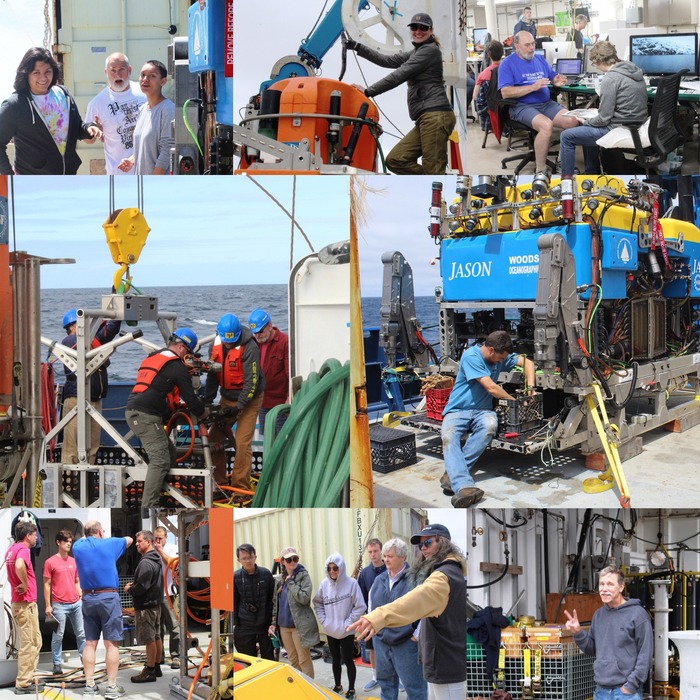 Scientists, students, engineers, chemists, geologists, mechanics, computer gurus, the Jason crew of ten, the R/V Revelle Captain, the 1st, 2nd and 3rd mates, chefs, oilers, electricians, deck hands and the plethora of others, assisting from onshore, have come together to carry out the Ocean Observatories Initiative, a unified vision.
Scientists, students, engineers, chemists, geologists, mechanics, computer gurus, the Jason crew of ten, the R/V Revelle Captain, the 1st, 2nd and 3rd mates, chefs, oilers, electricians, deck hands and the plethora of others, assisting from onshore, have come together to carry out the Ocean Observatories Initiative, a unified vision.
Focus, dedication and hard work yield the best scientific discoveries and also raise awareness of the "never ending need to know more", and as with children, the Cabled Array operations frequently bring unexpected learning and smiles from all. At the Endurance Array Offshore site, the Shallow Profiler Science Pod and Controller System (SC01A) was recovered and ROV Jason brought it topside. Once aboard, Applied Physics Lab Engineer, Trina Litchendorf, began to check and clean the instrument. She amazes me as she diligently completes her herculean task of readying, testing and caring for instruments pre- and post-dive. During cleaning she found a foot long fish stowaway (species unknown). The budding biologists that came running to see it, smiled, as she held up her prize fish, for photos. Trina has slept very little in the last 48 hours. The cabled array operations run 24/7 and require hard work, just like parenting. Now, to identify the species; maybe the UW fish collection team, including my daughter, Rachel Manning, Luke Tornabene, or Kathryn Maslenikov, can use the photo to identify the fish.
The Cabled Array operations are expensive and require significant funding, just like children, yet the discoveries are incredible and worth their weight in gold. Today, we watched with excitement as Jason explored Einstein's Grotto at Southern Hydrate Ridge and saw the rugged collapse zones complete with flowing methane-rich fluids. Thank you, National Science Foundation, for your funding and contribution, to aid in better understanding the unique, actively changing and critically important underwater ecosystem and natural resources located offshore of Washington and Oregon in the Northeast Pacific Ocean. It is clear, the Cabled Array, like raising children, takes a village and is a labor of love for the many "villagers" on this expedition.
June 24, 2018: REMOTELY OPERATED VEHICLE (ROV) JASON 101
ROV Jason operations have begun and student pairs have the opportunity and responsibility for logging and photographing Jason's underwater actions, accomplishments, challenges, and discoveries, from the control van. My buddy, Rachel Scott, and I were given the 4 hour shift from 8 PM to midnight. We were grateful we were not given a middle-of-the-night shift so we would be able to keep some semblance of a normal sleep schedule.
We entered the control van, which is an overwhelming eye-full of over 20 image screens and received a quick and thorough orientation from grad 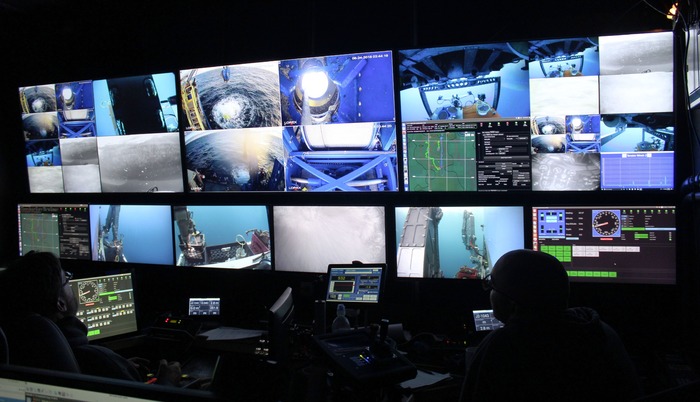 student, Brendan Philip, and began our tasks. My job was to monitor the HD 4K camera, log start and end times, take photos of the instrument retrieval, and dive highlights. Jason was at the tail end of retrieving the Slope Base Platform Interface Assembly (PIA), which was attached to the 200 M deep Shallow Profile Mooring platform, when we began logging.
student, Brendan Philip, and began our tasks. My job was to monitor the HD 4K camera, log start and end times, take photos of the instrument retrieval, and dive highlights. Jason was at the tail end of retrieving the Slope Base Platform Interface Assembly (PIA), which was attached to the 200 M deep Shallow Profile Mooring platform, when we began logging.
Jason has at least 8 cameras attached that are pointing in all directions, port, starboard, front, downward brow to the basket, and underneath to see coupling equipment. As a photographer, I was in my element taking pictures and watching the operations of Jason as the 5 crews operated Jason.
Watching the ROV pilot maneuver to couple Jason's latches to the PIA couplets was incredible because it was dark, the current was cruising, Jason was "floating" in 200 M of water, and the pilot's hand-eye coordination was impeccable. Feeling like I was underwater as I watched, I was awe-struck by the challenge and immensity of the cabled array operations, the seemingly effortless actions of the Jason crew, the expertise of the scientists aboard and the privilege of participating in this incredible endeavor. At midnight, I was tired but ready to see more of Jason underwater, the seafloor, learn more about the instruments and the information they yield and future new discoveries.
June 23, 2018: Docked in Newport, Oregon
Arrived in Newport boarding the Research Vessel (R/V) Roger Revelle, our home for the next 9 days. Experienced expedition guides, Eve Hudson and Katie Gonzalez, gave us a boat tour so we could get familiar with our surroundings. They showed us our sleeping and showering quarters, laundry, where to get linens for our bed, mess hall, library and main computer lab, how to tie down and secure our computers and chairs from the rolling boat motion, and how to log into the ship's internet. After the tour, I unsuccessfully tried to find my room again. Thankfully a seasoned engineer encouraged me by turning the ship schematic on the wall upside down so I could orient myself to the bow, stern, port and starboard sides. Then, I was able to find my room, main lab and the galley...just in time for supper. Dinner was excellent: halibut, veggies, fruit, rice and coffee.
After dinner, I studied the Cabled Array site and instrument summaries 2018 manual to learn more about the gear deployment history and underwater placement. This motivated me to take pictures of all the instruments and the ROV Jason loaded outside on the aft deck. Each instrument and Jason were loaded with color coded wires, connections, and gadgets galore. Back inside, I visited with Theresa Whorley and learned about the FLOBN-CAT (Chemical Aqueous Transport Flow Meter) and FLOBN-MOS A.K.A. MOSQUITO (Multiple Orifice Sampler and Quantitative Injection Tracer), un-cabled sediment fluid samplers which are located at the methane seep site - Southern Hydrate Ridge site. Theresa built the samplers and they are deployed one year then retrieved the next. These flow meters continuously collect pore fluids in the sediments, then after annual retrieval, the chemical composition is analyzed to understand chemical reactions occurring within the sediments. Hydrates are important to aid in understanding carbon sequestering and how methane diffusion could affect the adjacent biological communities and carbon flux from the sediment into the overlying ocean and out of the ocean into the air. So much to learn and yet so few days to take it all in.
As the sun was setting, seagulls flocked to the dock and a light wind carried the sea lion's voices to the boat. It was a beautiful afternoon, evening and sunset. Now, it's 11 pm. Time to sleep. Sweet dreams.

